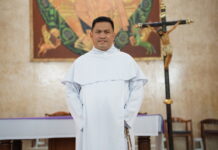
[bg|the_quadricentennial_pavilion|7|60|random|7|#FFFFFF|1|The Quadricentennial Pavilion]
FINALLY, a home befitting the school with arguably the most accomplished collegiate sports program in the country.
Located on an 11,784.33-square-meter lot at the former Engineering sports field is the Quadricentennial Pavilion, the 5,000-seat arena that is said to be the most advanced sports stadium in any Philippine university.
The structure, designed by chief architect Carmelo Casas, is now the home court of UST athletes whose proud history boasts of 38 overall titles in 74 UAAP seasons.
“The site and the client are very close to my heart. I practically grew up in that place,” said Casas, who also designed the multi-level car park that houses the AMV-College of Accountancy.
The four-story coliseum has an elevated ground floor, a design strategy to keep flood waters at bay.
Standing proud at the center of the Pavilion’s lobby is the steel sculpture, “Campeone” (champion) by Thomasian artist Joe Datuin. The sculpture won in the Olympic Committee Sports and Arts contest in 2008, the year after the first architectural plan for the Pavilion was designed.
Located on the first level is a dance hall for the Salinggawi Dance Troupe (SDT), as well as training halls for the fencing, table tennis, badminton, judo, and taekwondo teams. It also has a two-level fitness gym, a gymnastics room, and five lecture rooms for the Institute of Physical Education and Athletics (IPEA).
The Pavilion’s side facing the Benavides Park is apportioned for retail spaces like banks and restaurants.
The second floor will contain offices for guidance counselors, sports science, and for IPEA administrators. Two dug-outs and two lounges for coaches are also located on this level.
At the heart of the Pavilion is a maple wood court, which, according to Casas, is similar to those used by the National Basketball Association (NBA) in the United States. It is adorned with a tiger-striped border and a hand-painted tiger’s head, surrounded by red, orange, and yellow seats.
An indoor track is located on the third floor, whose windows will hold posters of memorable sporting moments and outstanding Thomasian athletes. There are also walkways to the mid-level seats of the basketball court, while on the topmost floor are the entrance ways for the seats in the last rows of the court.
Closed-circuit television cameras (CCTV) are positioned around the Pavilion and are controlled from an Information Technology Data room located on the second floor.
“All corners have CCTV cameras, with motion detectors,” said Vingie Maitam, one of the architects who worked on the Pavilion.
Casas utilized a double-wall design (two walls with a space between them) on the interior walls for noise insulation, while louvers are installed on the façade to accentuate the building’s exterior as well as minimize solar exposure to the interior.
Toilets and faucets in lavatories and comfort rooms are automated and air circulation is controlled by a centralized air-conditioning system.
Good but lacking
Despite these awesome features, not everyone is awed by the new structure. Architect Manuel Noche cited lapses concerning the pavilion’s location. For him, it lacks that “wow” factor “that tells the world that ‘Hey, this is the home of the Growling Tigers.’”
Located too near the walls, the Pavilion is blocked in plain view from the outside by trees in front of it.
“Coming from the outside, there is no sign that immediately shows the sports complex or a direct view to it,” Noche said. “Unlike the Main Building with the cross on top, which can be seen from almost anywhere in Manila, only one corner of the sports complex can be seen from the outside and not the façade itself.”
Noche hopes that the new stadium would inspire UST athletes to work harder.
“I also hope that this building will renew an extended rigor in our sporting prowess, especially our [men’s] basketball team, which last held the crown in 2006,” he said.
Stretching the dynasty
IPEA Director Fr. Ermito De Sagon, O.P. said the Pavilion would now provide a good venue for the varsity teams’ training, especially as the school guns for its 39th general championship.
“The new gym will affect us positively. When our old gym was demolished, the performances of our athletes declined,” he said.
Still, he said UST’s sports dominance would depend on the athletes.
“There’s no magic with the new gym. It does not mean that we have a new gym, and then we automatically win the overall crown. It still depends on the players on how they will perform. We are just giving what the athletes need to improve their performance,” he said.
De Sagon also debunked rumors that the Pavilion would be hosting games of the National Collegiate Athletic Association (NCCA).
“The gym can only accommodate our own athletes. We need a gymnasium for practice,” he said. “The athletes are still the priority for the UST sports complex. The capacity of the gymnasium on account of the audience increased but the space is just enough for the athletes.”
Lady Spikers chief tactician Odjie Mamon said that the new gym could strengthen the teams’ skills and conditioning for upcoming sporting event. He noted that the absence of a permanent training venue this season decreased the team’s conditioning to about 40 percent (seven and a half hours per week), a far cry from the recommended 16 to 18 hours training per week.
“We were not able to develop our serving and receiving skills due to lack of a permanent training spot. Also, our current practice venue, the seminary gym, has a low ceiling so it greatly affected our attack and serving drills,” he said.
SDT president Adams Bernabe said that the new gymnasium was “more cheering friendly” with its higher ceiling and bigger space, compared to the old gymnasium’s Annex building.
“With a higher ceiling, we can practice our lifts. Moreover, its floor material is suitable for dancing, so it is comfortable for us to rehearse,” he said.
For Lady Judokas coach Gerard Arce, the new sports gymnasium can encourage the team’s recruitment of new players.
“The new gym can strengthen the recruitment [since] we will have the space and time for try-outs of new athletes. It will be a great help for us to have a permanent place to train because we don’t need to think about the distraction like PE,” he said.
However, Dindo Simpao, coach of the perennial taekwondo champion, said the training venue is not really a big deal because snatching another title falls in the hands of persevering players mentored by their coaches.
“There are standard things that you need to provide for a team to excel. Take us anywhere and there’s no difference, we will still be champions,” he said.













